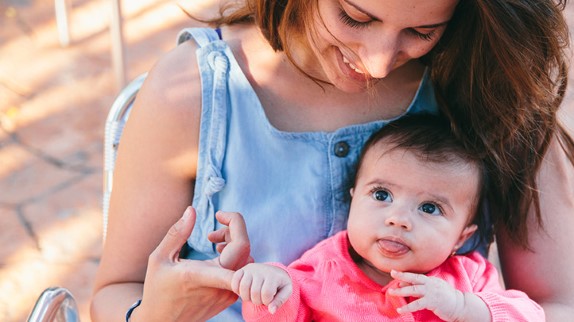After months of reclining and tummy time, your baby might be ready for a change of scenery, and he’ll need to accomplish a new movement milestone to do so: sitting up.
The more practice your little one gets holding himself upright in an assisted seated position, the sooner he'll discover the pleasures of sitting up on his own — including a better perspective on all his favorite toys (and his favorite people).
When do babies sit up?
Most babies can sit with help between 4 and 5 months old, either with a little support from a parent or a seat or by propping themselves up on their hands, but it definitely varies from baby to baby. At this age, most babies' heads will slightly or no longer fall backward when their upper bodies are pulled up to a sitting position.
Starting in month 4 (or whenever he holds his head up well and seems interested and ready), you can prop your baby up to sit with support and give him an amazing new vantage point on the world around him.
Help your baby develop neck and head control by making a game of pulling him up to sit. With baby lying on his back (or perhaps your legs), grasp his hands and gently pull him up to sit. Some funny faces and zooming noises will help him enjoy the ride.
When do babies sit up on their own?
Babies can stay sitting up unassisted when they’re around 6 months old, when the neck, upper body and back muscles have more fully developed, but sometimes they get the hang of it earlier or later. Like other movements, there’s a wide range of normal.
By 7 months, some babies may sit up from a lying-down position by pushing up from the stomach, but most little ones will need a grown-up pulling them up or placing them into a sitting position until around month 11.
Read This Next
Either way, at the end of 7 months, your baby should be able to sit unsupported. If this milestone isn't met, check in with your physician.
How do I get my baby to sit up?
As soon as he holds his head up well, you can help encourage your baby to sit up a few different ways:
Prop him up in an infant seat, stroller or your lap.
Sitting up with support in the stroller while you take a neighborhood walk is an especially good way to develop your baby's interest in sitting. As you walk, point out all the new things he can see from his upright position, from dogs and cars to passersby and other babies in strollers.
Give him something to hold onto — and a cushion to break any falls.
The more practice your baby gets sitting with help, the more likely he is to try sitting up on his own without a pillow or a grown-up’s hands to support him. To steady his wobbly sense of balance, roll a ball and play catch while you're both sitting, or hold his hands and sing a song, gently swaying to the rhythm.
As he's learning to sit, keep him on a blanket or activity mat to cushion any tumbles, and sit close by so that you can catch him if he topples over backward.
Use toys as an incentive.
Try placing a toy in front of your baby's feet while he's sitting, and he may end up propping himself up on his hands as he plays with it. You can also place a toy near the top of his feet to get his attention. Then lift the toy up to his eye level. He'll reach for it while sitting up — and may even be able to stay seated on his own while he plays with the toy in his hands.
What not to worry about
As long as you give your baby plenty of opportunities to practice his sitting skills, he'll let you know when he's ready to sit up.
If your baby slumps over or slides off to one side even with support, he may not be ready to sit, and you can simply try again later. And babies who are new to sitting up may tire easily — he'll let you know when he's had enough by fussing, complaining or slumping.
If your little one doesn't sit with support by the end of month 5, it's not a cause for concern. Every baby develops differently and at his own pace.
Just continue to offer plenty of chances to practice sitting with support, and lots of encouragement and distraction while your little one is upright so that he gets to use and develop those upper body muscles. Try putting his infant seat next to a mirror or taking an extra spin around the block in the stroller.
When do babies sit up and crawl?
Plenty of practice sitting upright (plus tummy time) will help your little one develop the upper body strength he'll need to start crawling — usually around the 9 month mark. Some babies will begin crawling as early as 6 months, while others hold off and some even skip crawling altogether.
Teaching your baby to sit up can help kickstart his first crawling movements. In fact, babies often "discover" crawling from learning to sit. If he leans over while sitting, he may realize he can prop himself up on his hands and arms before rocking back and forth and, eventually, moving forward inch by inch. Sitting is just another (figurative) step forward toward your baby's first steps.




 Trending On What to Expect
Trending On What to Expect






